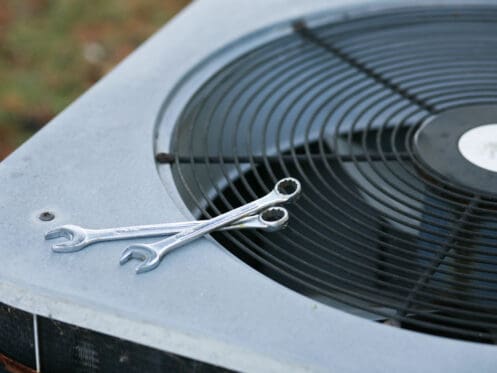If your HVAC system is more than a decade old or you find that it needs repairs regularly, a replacement might be necessary. Over time, HVAC systems become less efficient, which means that they will use up more energy when heating and cooling your home. If you’d like to avoid wasting more money on your monthly energy bills, consider upgrading to a new unit. Along with providing reliable comfort, a new system should also help you substantially reduce your electric bill.
Choosing the Right HVAC System
There are many factors you should consider when looking for a system that’s right for your home. Among the most important of these factors is that the HVAC system keeps you and your family comfortable.
Size
The HVAC system you buy should be large enough to regulate your home’s indoor air temperature. If the unit is too small, it might not be capable of heating and cooling the entire space. An HVAC system’s size is measured in British thermal units (BTUs). A higher BTU rating equals a greater capacity.
Price
Prices differ depending on your needs and the type of system you’d like to buy. It’s common for ductless mini-split units and geothermal systems to cost more than the alternatives. The system’s energy efficiency also dictates the type of price you’ll pay.
Brand
Today, there are numerous HVAC brands that produce high-quality and reliable units, which means that selecting a unit based on its brand is usually a personal preference. The HVAC installer you hire can help you choose an HVAC system based on brand. You can also search online for reviews. While components are comparable no matter which system you choose, warranty coverage can vary by brand.
Efficiency
Over the years, HVAC unit efficiency has improved. While there are several rating systems that can be affixed to these units, the most common is the seasonal energy efficiency ratio (SEER). A higher SEER number means that the system is more efficient. Modern units have SEER ratings between 15-23.
Steps During Installation Process
The installation process can be separated into four distinct steps. However, the exact details of the installation process differ slightly with each professional HVAC company. Before you hire an HVAC company, make sure you understand what the HVAC process entails.
Prepare the Site
Before the installation team gets to your home, it’s likely that you’ll receive a text or phone call that tells you they’re about to arrive. Once the team arrives at your home, they’ll discuss the job with you and provide an informational packet that contains details of the equipment they’ll be using and any accessories that are being installed.
Before work begins, the team should review the site to make sure that mistakes are kept to a minimum during the installation process. Other team members should put down floor protection around the unit that’s being removed. The gas supply or electrical circuits will also be turned off.
Remove Old Unit
Existing air conditioners come with a refrigerant that should be removed before the actual unit is taken out of its place. A recovery tank will be used to safely remove the refrigerant. Keep in mind that any team member who performs this process must have EPA certification to handle the solution.
Once all refrigerant is recovered, the nearby electrical wiring will be disconnected, which ensures that the HVAC unit is shut down completely. When all existing connections to the electrical panel have been removed, it’s possible to get rid of the system itself.
Additional Preparations
In many situations, the area surrounding your old HVAC unit will need to be prepared before the new one can be installed. Unless you’ve purchased a very similar system, the slight differences between each model could require small alterations to be put in place.
For instance, the pad that your old system sat on may need to be replaced. Many modern HVAC systems are taller and larger than older units, which is why a new pad is necessary. It’s also possible that the ground below the HVAC system has sunk slightly. Before the installation team can set the new pad, the ground will need to be leveled, which can be done with a gravel base.
The installation team you hire could also choose to pour a concrete pad. This pad isn’t needed because it can crack and shift significantly while the system is installed. Cracks in concrete are difficult to efficiently repair, which is why a composite pad is likely the option that your HVAC installer will go with.
Install New System
Now it’s time to install the new system. This process can differ slightly depending on the system you buy. For instance, let’s say you purchase a ducted air conditioner. In this scenario, the air handler will be attached directly to the ductwork before the remainder of the installation process occurs. Refrigerant lines will also be connected to the equipment, after which it’s possible for the electricity to be reconnected and the nearby drain to be reattached.
Before this process concludes, the HVAC team will likely install a new thermostat. These devices must be connected to the unit and programmed to communicate directly with the new system. If you’ve purchased surge protectors or air quality products, these will be installed before the team cleans the surrounding area.
After the installation process has been completed, the unit is unable to be lifted or moved without causing significant damage to the area. Many components inside an HVAC unit are pressurized. Hiring a reliable HVAC contractor limits the possibility that the installation process will be performed incorrectly.
Test HVAC System
Once the installation is over, the unit will be powered on to ensure it works properly. Your installation team will likely let it run for a few minutes to determine if all components are functioning correctly. The main aspects of the unit that are tested include the supply air temperature, drain function, refrigerant levels, and airflow. Technicians can make small alterations to make sure every component works.
Before your installation team leaves, they should clear all tools and debris from the floor before getting rid of the mats that were laid on the ground. Take this time to ask any question that comes to mind. If you have a new thermostat, the lead installer should help you understand how to use it. You should have a clear understanding of warranty information and maintenance schedules before the installer leaves.
If you’re considering upgrading to a new HVAC system, our technicians at First Choice Plumbing, Heating & Air Conditioning offer quick installation services for Metuchen, NJ residents. We know what it takes to remove all types of HVAC units and replace them with new models. Whether you have a mini-split unit or a central air conditioner, our team strives to get your new system up and running without issue.
During the installation process, we take care to keep the surrounding area clean and free from debris. We also offer additional residential services, which include HVAC repair and maintenance, plumbing repair, and indoor air quality. Call First Choice Plumbing, Heating & Air Conditioning today to schedule an HVAC installation.




